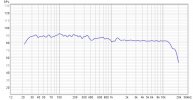Thanks for your reply. Yes, I do use Dynamic EQ. I suspect that the benefits of that dynamic adjustment do not show up in the seconds-long test tone. I would say my sound is anything but lacking in bass response. That said I've taken your response and @PeterNL's as well and adjusted the Curve Editor to make the downwards sloping bass-heavy curve. That has further increased the bass response, though I swear the results do not show up in the graphs below.With Audyssey, I suggest using Dynamic EQ. As another member said, the response looks "bright," as in low bass relative to mids and highs. Dynamic EQ will elevate the bass region (and do a few other things). That should address the brightness / weak-ish bass sound.
I assume this is Audyssey "Reference" EQ, not "Flat."
The "offset" setting (15, 10, 5, 0) for each input like for music, TV, movies, should be based on how loud you normally listen. The amount of "dynamic EQ boost" is the same for each, but each assumes a different target volume level and add more boost the farther you go from that volume level (eg., every 5dB or notches down, it adds X dB more boost on a curve). Movies are usually mixed with 0 on the dial as the target, so if you listen to movies and TV at around -20, you get much more boost with a "0" offset setting (it senses 20dB low) versus if you set it to "15" (it senses you are only missing the target volume setting by 5dB). For music inputs like streaming or a CD player, your normal volume setting might be -30 to -35, so an offset setting of "0" will add a ton of boost, and a setting of "15" might sound much more natural.
On my Marantz receiver, I use an offset of 15 for my music inputs, and 0 / 5 for TV/movie inputs, adjusting to taste with different material as needed.
If you do REW readings with Dynamic EQ turned on, you will get different graphs depending on your input level and what the volume dial is set to. For example if you have offset set to 15 and the volume dial is at -15 in order to get enough volume to register on the mic / REW, you will not see any boosts in the response. If you set DEQ offset to 0 and have the volume dial at -15, you will see the boost you get at 15 below the offset number (-30 dial on 15 offset, -25 dial on 10 offset, -20 dial on 5 offset, -15 dial on 0 offset). Conversely, if you set the dial to 0 to get enough volume to do REW readings, and the DEQ offset is at 15, you will see a reduction in the bass because it thinks you are 15dB past max volume level and it is protecting your speakers.
You can see the boost graph here, and that there is some slight boosting to frequencies over 8K as well.

Audyssey Room EQ Review
That seems reasonable, but if I want to create such a target curve based on Harman's findings on the preferred tilt similar to the one Amir did in one of his reviews, then I would want to consider the slope of the tilt vs my listening level(s). And if I decide not to use DEQ, then I would...www.audiosciencereview.com
This morning's results look decent but very similar despite all the different speaker and EQ settiigs:
Now, this evening so far, I have added the bass heavy slope to the Curve Editor -- and the bass response is 40 dB lower than the rest of the frequency range, across the board in all EQs and speaker settings (with and without the subwoofer:
So I'm completely confused by the above graph now. I really appreciated your explanation of the Reference Offset, though it still left me somewhat confused, given what I hear. It sounds like the setting that will produce the most low end would be the 0 Offset, which is what I kind of understood from the manual, but your explanation is more thorough (even if I can't definitely say I understand the effect). At any rate, changing to 10 and 15 seemed to produce less bass when listening to Taylor Swift - Lavender Haze at 50 on the dial, which has become my primary bass testing song of late. At any rate, getting frustrated with the graph above and the bizarrely quiet bass response it shows, I've been listening to actual music with my "Audyssey Slope2 without subwoofer at volume50" settings and there is insane good bass, and balanced with crisp, defined vocals and instruments front and center in the mix, while enveloped in deep wide bass. Even though bass didn't seem overly weak before, it's definitely not now. I'll keep listening to my stereo-testing playlist, then put the new copy of Dave Brubeck that arrived on vinyl today and see if analog jazz comes across just as lovely.
*p1 speaker setting has no Subwoofer; p2 has a subwoofer; v60 means volume set at 60, which is pretty loud for streamed music; Slope2 is the second bass heavy curve int eh Curve Editor

